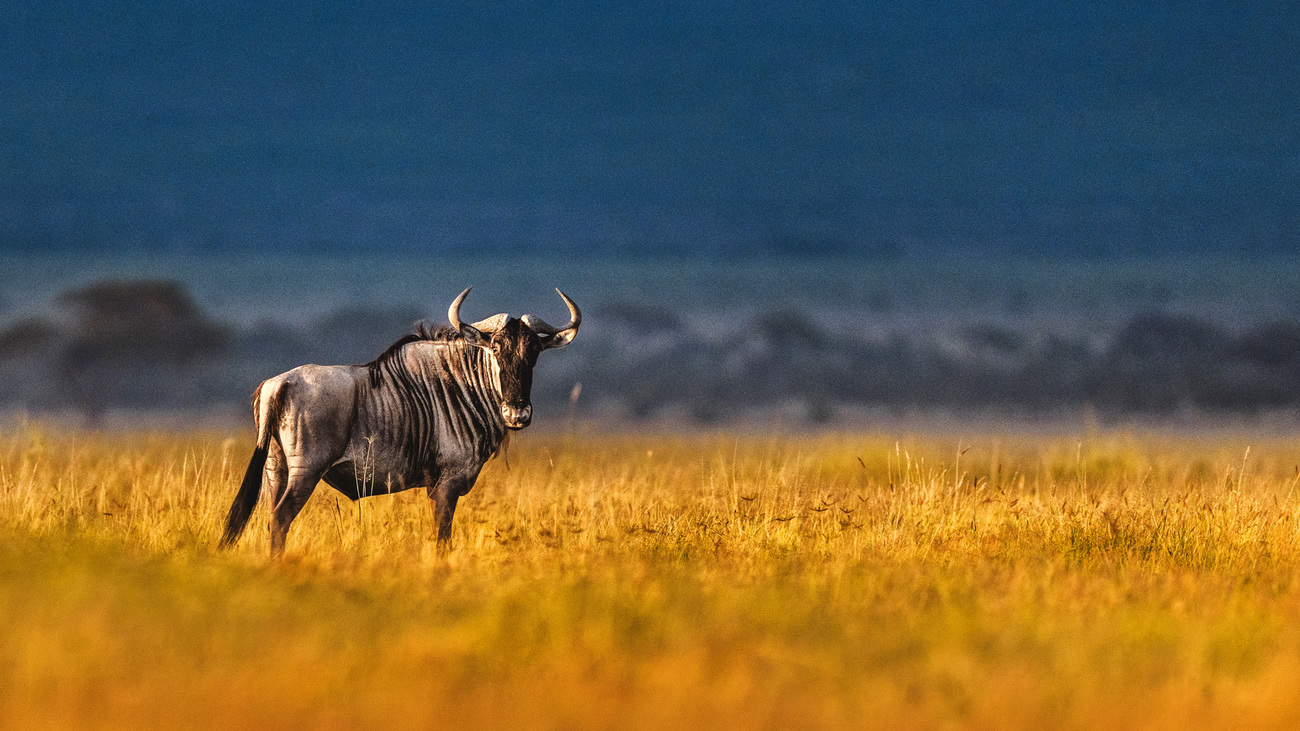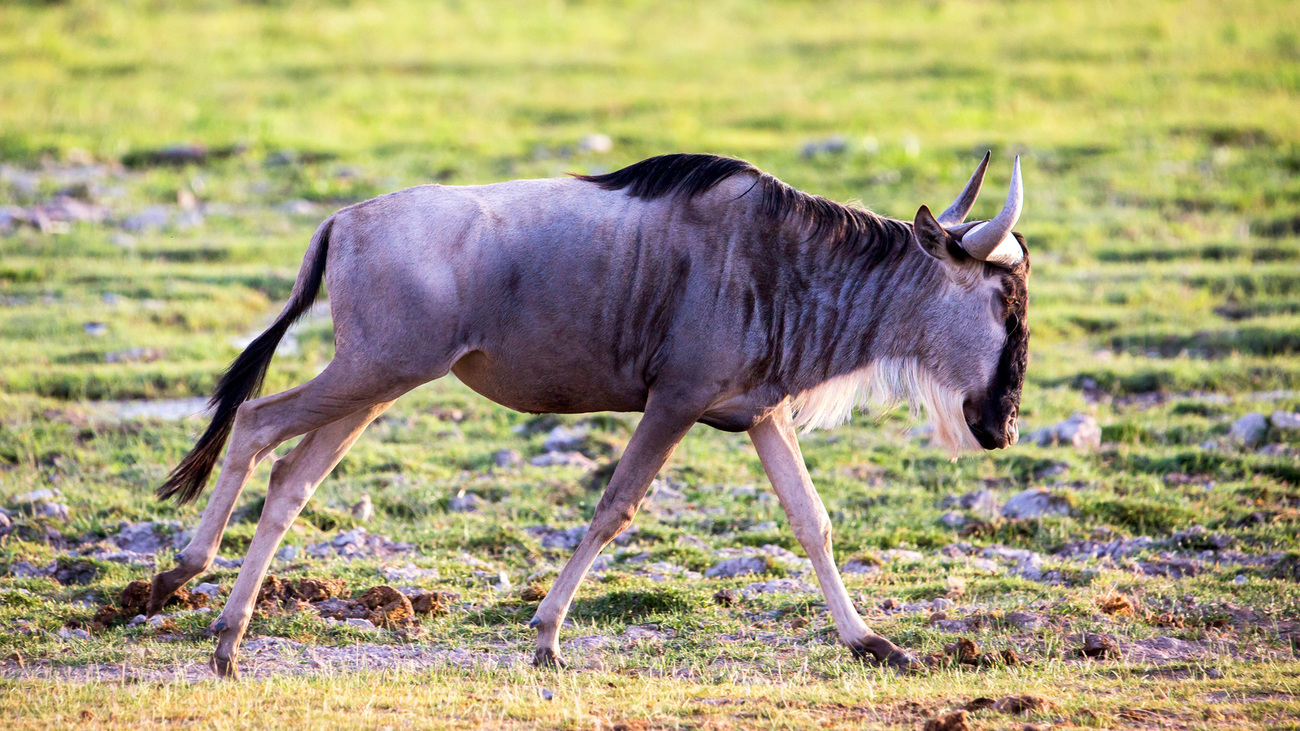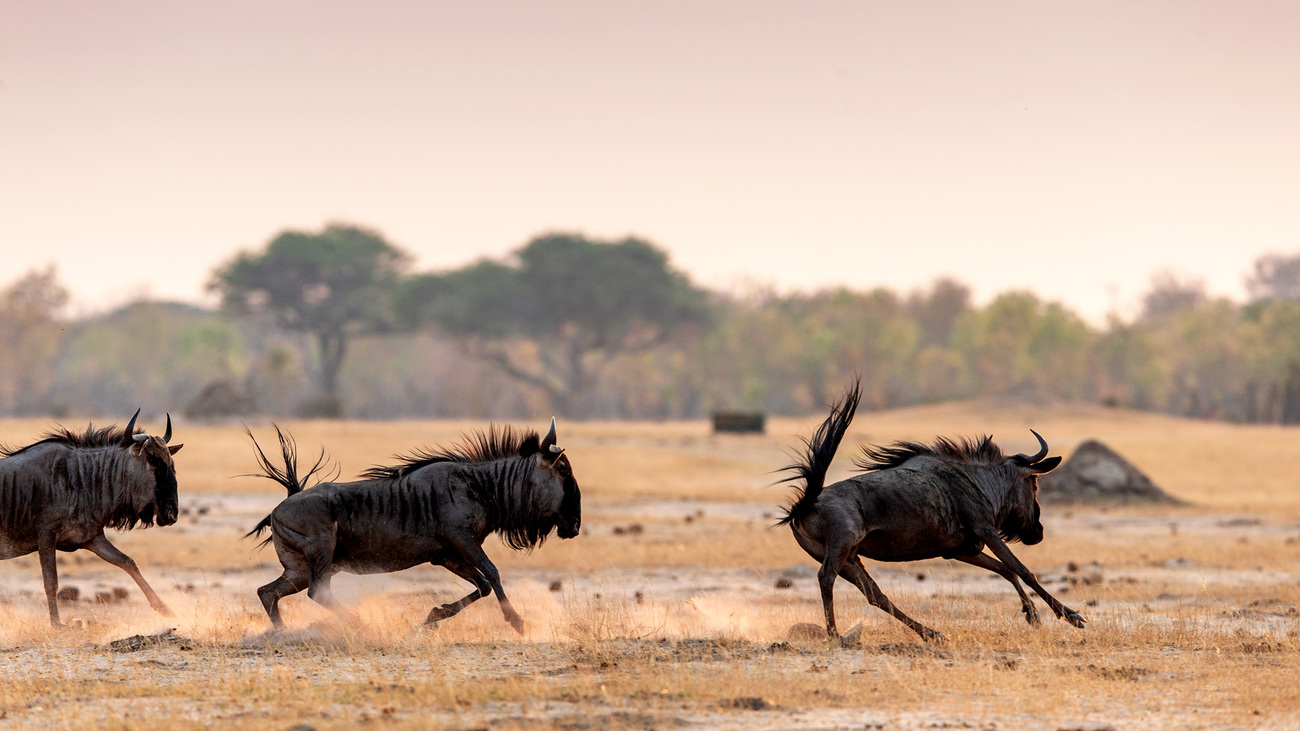Wildebeests
What is a wildebeest?
Wildebeests, also known as gnus, are hoofed mammals of the Bovidae family. There are two species of wildebeest, the common wildebeest (Connochaetes taurinus) and the black wildebeest (Connochaetes gnou). Their Afrikaans name ‘wildebeests’ comes from the description ‘wild beast’, which refers to their beastly appearance.
The common wildebeest has high, sloping shoulders with a hump, a short neck, a long tail, and a bovine face that resembles that of cattle. Their coats are brownish-grey, and they have a mane and beard. Both male and female common wildebeest have distinctively large, curved horns.
The common wildebeest has five subspecies, including the blue wildebeest, the western white-bearded wildebeest, the Nyasaland wildebeest, the eastern white-bearded wildebeest, and Cookson’s wildebeest. The blue wildebeest is the largest of the subspecies, weighing 230 to 275 kilograms (500 to 600 pounds) and measuring 140 to 152 centimetres (4.6 to five feet) tall. The western white-bearded wildebeest is the smallest, weighing around 50 kilograms (110 pounds) less than the blue wildebeest and standing 10 centimetres (four inches) shorter.
The black wildebeest, or white-tailed gnu, is the second wildebeest species. It’s significantly smaller than the common wildebeest, weighing 110 to 147 kilograms (242 to 324 pounds) and standing 106 to 121 centimetres (3.4 to 3.9 feet) tall.
Common wildebeests are primarily found in the grasslands and savannahs of eastern and southern Africa. They are herbivores and graze on grasses and other kinds of vegetation. Wildebeests are known for their extensive migrations, moving in large herds across vast distances in search of food and water. When the rainy season ends, they roam the acacia savannah, where there are more abundant water sources and fresher, taller grasses.
The wildebeest is a highly social animal that stays in larger herds for protection against predators. During migration in June, the Serengeti gnu population breeds in large numbers. Around 500,000 females mate with thousands of males, creating a very loud and busy spectacle.
After an eight-month gestation period, the females all give birth to their calves around a similar time. Unlike most other antelope-related species, the wildebeest calf can stand and walk quickly after birth, which is believed to be an adaptation to their migratory behaviours.
Wildebeests are a keystone species in the plains and acacia savannah ecosystems spanning southeastern Africa to central Kenya. Their annual migrations play a vital role in nutrient cycling and maintaining grassland health. As the herds move, they graze on vegetation and prevent it from overgrowing. Interestingly, their deaths also play an important role in the health of their habitats. Each year, thousands of wildebeests die in the Mara river during migration. Not only do their carcasses feed a breadth of scavenging creatures—including crocodiles and river fish—but their bones also act as a slow-releasing fertiliser for the land.
Read on for even more fascinating facts about wildebeest.
What is a wildebeest’s scientific name?
There are two species of wildebeest, the common wildebeest, scientifically known as Connochaetes taurinus, and the black wildebeest, scientifically known as Connochaetes gnou.
Are wildebeests endangered?
Thankfully, both the common wildebeest and black wildebeest species are classified as least concern by the IUCN Red List. However, this doesn’t mean they don’t face threats to their survival in the wild.
The population of the common wildebeest is stable, with their most recent population estimate at 1,550,000, as of 2009. The black wildebeest population is increasing, with an estimated 11,158 individuals in the wild.
Where do wildebeests live?
Wildebeests are found across southern and eastern Africa. More specifically, the common wildebeest lives in the dense woodlands and floodplains of southern Africa and parts of Kenya and Tanzania, while the black wildebeest lives exclusively in South Africa, Lesotho, and Eswatini in open grasslands and Karoo scrub.
Threats
There are several threats to the stability of the wildebeest population, including blocked migration routes, habitat loss and fragmentation, and hybridisation.

Blocked migration routes
Wildebeests migrate long distances between wet and dry season ranges to ensure they always have access to plenty of water and food sources. Fences and other human infrastructure have led to the death of huge numbers of wildebeests that sought higher-rainfall areas during periods of severe drought.
In 1980, thousands of Botswana wildebeest died when they attempted a drought-induced migration but were blocked by veterinary cordon fences.
Habitat loss and fragmentation
Despite currently having an abundant population, the future of wildebeests’ survival may be threatened by the growing issue of habitat loss. As more land is converted into farmland and fenced off for agriculture, it fragments wildebeest populations. This prevents them from migrating freely and finding food and water sources.
Human activities have also removed natural sources of water for wildebeests, including watershed deforestation and expropriation for irrigation.
Hybridisation
The two species of wildebeest, the common wildebeest and the black wildebeest, do not interbreed naturally. However, as the two species become more fragmented and trapped within isolated, fenced areas, the likelihood of hybridisation increases. A study of hybridised wildebeest found that they had abnormalities in their bone structures.
Restricted habitats also reduce the genetic diversity of the wildebeests, which in turn can lead to poorer health and leave them more susceptible to contracting disease.
FAQs
What do wildebeests eat?
Wildebeests are herbivores. They feed on the tall and short grasses of savannahs and grasslands within their habitats. While they may sometimes consume other vegetation, all wildebeests combined typically eat more than 4,500 US tonnes—about 4,100 metric tonnes—of grass each day.
Do wildebeests migrate?
Yes, wildebeests are known for their annual migratory patterns. Their migration involves large herds of wildebeests—along with other herbivores, such as zebras and gazelles—moving in search of fresh grazing pastures and water sources. The wildebeest migration follows a roughly circular route of up to 1,610 kilometres (1,000 miles) in the savannahs and grasslands of East Africa, primarily in the Serengeti, spanning Tanzania and Kenya.
Their migration starts right after the birthing season at the beginning of the year. Many wildebeests get lost, injured, or killed during these difficult journeys. Their migration is also linked to seasonal changes in weather and vegetation. Their movement is triggered by the availability of fresh grasses and the need to find water sources.
What does a wildebeest look like?
The Afrikaans name wildebeest comes from ‘wild beast’, referring to the beastly appearance of the animal. The common wildebeest has a shoulder hump that slopes down, with a short neck, thin legs, and a long tail. Its coat is a lighter grey to darker brown colour, and it has a mane and beard. Both male and female common wildebeests have horns that resemble those of cows.
The black wildebeest has a darker coat of dark brown to black and a white tail, beard, and mane. It has curved horns that are between 45 and 78 centimetres (17 and 30 inches) long.

How many wildebeest are there?
It’s unknown exactly how many common wildebeest there are, though the most recent estimate in 2009 was 1,550,000 individuals. There are roughly 11,158 black wildebeests remaining.
How big are wildebeest?
The largest of the common wildebeest subspecies, the blue wildebeest, weighs 230 to 275 kilograms (500 to 600 pounds) and stands 140 to 152 centimetres (4.6 to five feet) tall. The smallest subspecies is the western white-bearded wildebeest, which weighs approximately 50 kilograms (110 pounds) less than the blue wildebeest and is 10 centimetres (four inches) smaller.
The other species of wildebeest, the black wildebeest, is smaller than the common wildebeest. They weigh 110 to 147 kilograms (242 to 324 pounds) and stand around 106 to 121 centimetres (3.4 to 3.9 feet) tall.
How fast can a wildebeest run?
Wildebeest are exceptionally fast runners, reaching sprinting speeds of 80 kilometres per hour (50 miles per hour). This quick pace can help them outrun predators, especially as they’re able to maintain such high speeds for longer distances.

What makes the wildebeest a keystone species in the Serengeti?
The wildebeest has a huge impact on the ecosystems of the Serengeti. By consuming large amounts of grass, wildebeests create more room for trees to grow—trees which provide food sources and shelter for other animals, like giraffes and birds. As they migrate across the Serengeti, wildebeests also leave behind vast amounts of dung, which acts as a natural fertiliser for the landscapes. The carcasses of the wildebeests that die during their travels also fertilise the land and provide food sources for a wide variety of animals, including crocodiles and fish. Their decaying bodies add approximately 13 US tonnes of phosphorus, 25 tonnes of nitrogen, and 107 tonnes of carbon (12, 23, and 97 metric tonnes, respectively) each year to the land, contributing to its health and fertility.
The stable populations of wildebeest also serve as an abundant food source for their predators, including lions, cheetahs, wild dogs, and hyenas.
Are wildebeest antelopes?
Yes, the two species of wildebeest—the common wildebeest and the black wildebeest—which are also known as gnus, are large African antelopes of the family Bovidae—in the broadest definition of the term. They belong to the subfamily Alcelaphinae.
However, a narrower definition of ‘antelopes’ includes only the genera Gazella, Nanger, Eudorcas, and Antilope. So, while wildebeest are antelopes in the broadest sense, they are not ‘true’ antelopes.

Are wildebeest endangered?
While the wildebeest is not currently endangered—both species are classified by the IUCN Red List as least concern—they do face a number of threats.
The ongoing survival of wildebeests is threatened by blocked migration routes, which prevent the animal from carrying out its natural behaviour of travelling long distances in pursuit of fresh food and water. Fences that prevent wildebeests from passing can also prevent them from eating or drinking during periods of extreme drought, leading to high death rates for the animals. These fences are usually set up to section off land for farming or agricultural practices. This creates habitat loss for wildebeests and fragments populations, meaning they cannot join together for breeding.
As a result, the two wildebeest species have begun to mate unnaturally in a process known as hybridisation, the interbreeding of two different species, which creates issues for the hybrid animals. The fragmentation of these wildebeest species also reduces the gene pool for the animal, which can lead to less healthy populations that are more susceptible to fatal diseases.
How can you help?
To help conserve wildebeest populations and protect them from the threats they face, we need to reduce the threat of habitat fragmentation.
